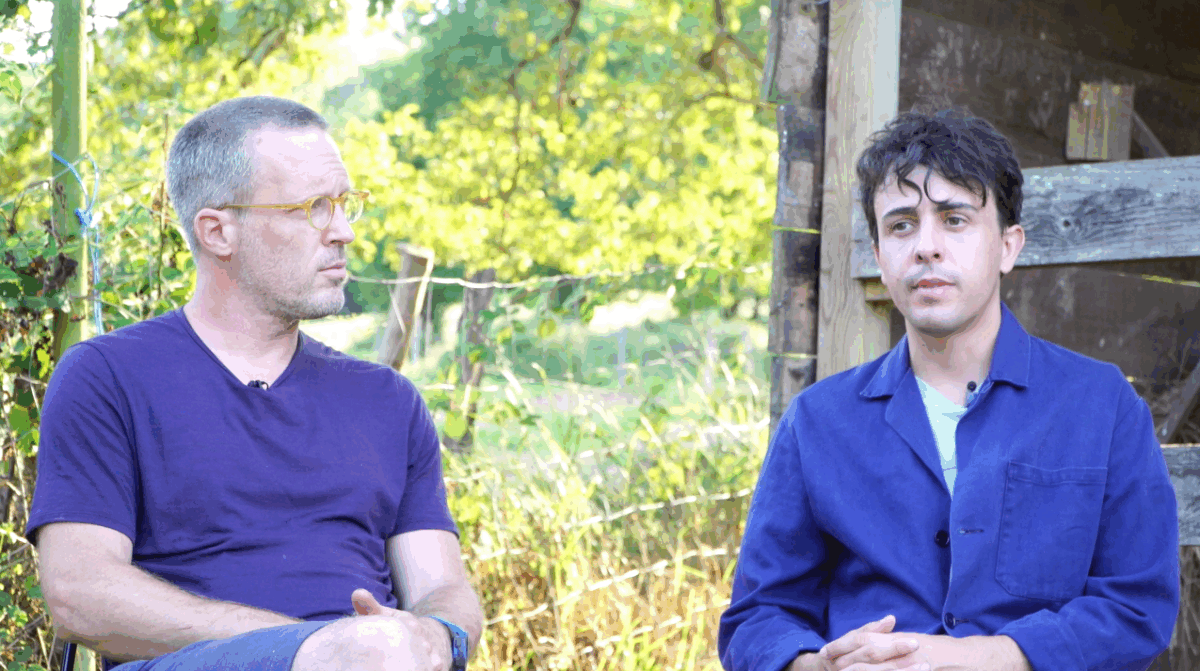"It is essential to understand the river, not only as a natural entity, but also as a social, cultural and political element".

Interview with 'Aguas Vivas' mediators Sören Meschede and Alejandro Alonso Díaz.
Since last April, the mediators, Sören Meschede y Alejandro Alonso Díaz, work with the Llanos community of comitentes in Cantabria to reflect on “the historical interactions between humans and water”, seeking to generate a common meeting space around the river and its relationship with the environment, tradition and the fabric that sustains and builds the links in this rural environment. In this interview, both mediators talk to us about the beginning of the project, the context in which it arises and the keys to their methodology to activate listening, participation and exchange that will shape the future artistic commission.
Concomitants: Do you want to introduce yourselves?
Sören Meschede: I am a mediator for Concomitentes and have been living in Cantabria, in a village near Llanos in the Pasiegos Valleys, for three years.
Alejandro Alonso DíazI am the mediator of the concomitance ‘Aguas vivas’ and director of fluent, an organisation dedicated to contemporary art which, in this case, relates and situates the project in the territory.
C: How did this project come about?
AAD: It responds to a series of concerns, both Sören's and mine, to apply the methodology of Concomitentes to a rural territory in order to delve into the complexities and specificities of this type of territory. The various crises that are occurring find their echoes in the village and the community that inhabits it, a diverse population intertwined with the natural ecosystems and the socio-cultural heritage of the area.
C: Why did you decide to do this project here?
SM: We were looking for a committed and interested community, which has varied in number of members but has become a stable working group that is the core of this whole process. This is how we decided to work with this people in Cantabria.
C: What cause or desire are you working on with this group?
AAD: During these months, “waves of desires or possibilities” have been put on the table that we could implement and realise through the commission. One of these desires was to generate a space to enable and encourage encounters, while another recurring desire was to work with the environment, until finally both resulted in the possibility of combining both desires through the relationship with the river.
SM: In this sense, our interest, and the interest of the commissioners, is to work on the natural heritage, the river, and the environment of the village. The natural environment, but also the intangible cultural heritage, which are the customs, traditions, the forgotten or new uses that are made of the river. It is a work that will certainly oscillate between the social and the environmental, and whose concreteness will depend on the artists we invite.
AAD: We think of the river as a channel that connects and crosses the Pasiegos Valleys, joining other rivers and tributaries and generating a network of circulation between rural and urban territories. On a symbolic but also practical level, it means working with a device that is already talking about the common and its challenges, about a space of connection between people and its fragility. In this sense, it is essential to understand the river, not only as a natural entity but also as a social, cultural and even political element, due to all the decision-making involved in terms of generating infrastructures around it or intervening in its course, uses and dynamics.
C: The issue of drought and the management of water resources is nowadays very contingent on...
SM: Yes, this has been a historically dry summer, so the theme has become a very interesting protagonist for the Cantabrian environment, which has always had an abundance of water, but which is now presented as a scarce resource that must be looked after.
AAD: This scarcity also makes us look with interest at the whole wealth of traditions and knowledge linked not only to the river itself, but to everything that exists around it, such as springs or fountains, and the infrastructures that are linked to it, such as bridges, dams, mills...
SM: Popular customs...
AAD: Popular customs and traditions that the working group brings with them as a fundamental part of their identity. Some of the members of this citizen group are members of previous generations who have joined the debate on the uses of the river, its transformation in terms of function and its role in society at different historical moments.
C: How was this assignment or desire to work on selected?
SM: We have worked with debate and discussion groups, which have been held through weekly meetings between April and July, every Wednesday at 20hrs. After this process and a slow process of defining what the different possibilities that were considered would entail, on 26 June we held a popular vote open to the whole town in which the option of working with the river was chosen.
C: Where did the name of the project come from?
AAD: During the sessions with the working group, the name ‘Living Waters’ came up very informally, which resonates, albeit unintentionally, with the work of the Brazilian writer Clarice Lispector, Living water. Like the Llanos community, Lispector seeks through this book a certain sense of vitality which, in our case, involves defining a space in which that experience can take place.
C: What role does listening play in this whole journey?
AAD: We have come this far through a collective listening exercise between all the people who make up the working group and the community. Now we must think about how to open ourselves to other forms of listening and make a deep understanding of the river, understanding it as another voice in the process. We must remain attentive to its needs and times, to its presence and absences, and to how it transforms itself during the different times of the year.
C: What has it been like working to reach common agreements in such a large and diverse community?
AAD: Generating complicity between the individual views of each of the people in the group and their desires has been precious. There was a difficult moment in which these individual preferences gave way to a collective view that started with a slow process of negotiation. Starting from a biased subjectivity, space was gradually ceded to a group sensibility and vision.
SM: In this collective sensibility, a fundamental factor has been the vision contributed by older women who demanded the need for social or collective spaces, including the river as one of them. We are now at a point where we must ensure that the river becomes a space for the community and that it is given the value it deserves.
C: What are the next steps?
SM: From September we will continue with a series of work residencies to which we will invite various artists to dialogue and build with the working group. We hope that, from here, we will generate the definitive project that we can inaugurate at the beginning of 2024.










 Concomitentes
Concomitentes